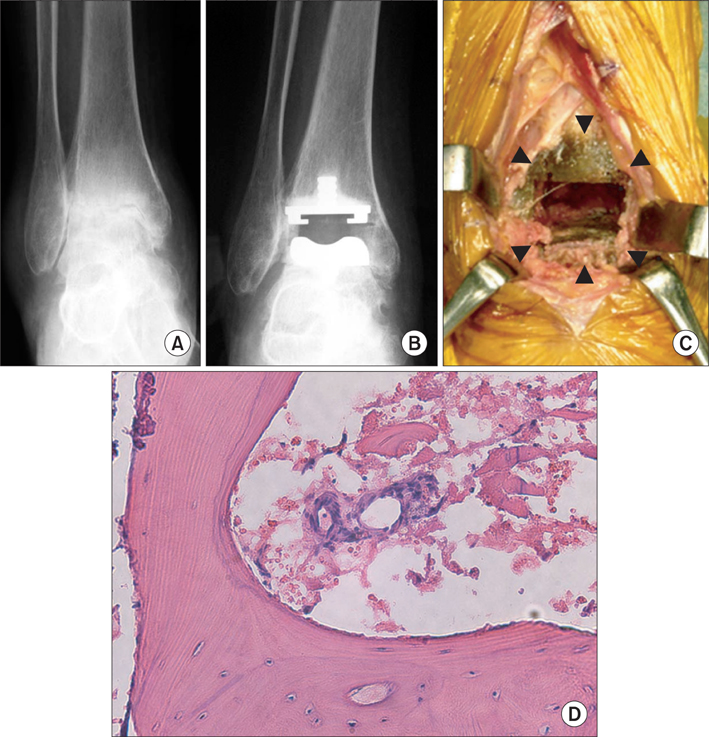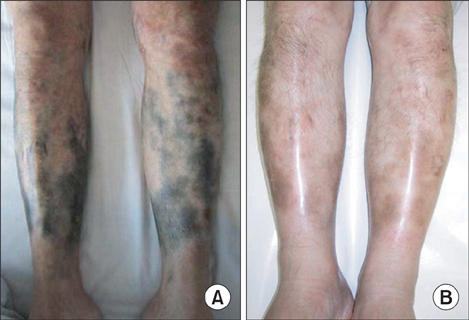Clin Orthop Surg.
2012 Sep;4(3):181-187. 10.4055/cios.2012.4.3.181.
Minocycline-induced Periarticular Black Bones in Inflamed Joints Which Underwent Arthroplastic Reconstruction
- Affiliations
-
- 1Department of Orthopedic Surgery, Yamagata University School of Medicine, Yamagata, Japan. yangsuran@gmail.com
- 2Department of Medicine, Biomedicum Helsinki, University of Helsinki, Helsinki, Finland.
- 3Department of Orthopedic Surgery, Sanyudo Hospital, Yonezawa, Japan.
- 4Department of Orthopedic Surgery, Yamagata Saisei Hospital, Yamagata, Japan.
- KMID: 1392979
- DOI: http://doi.org/10.4055/cios.2012.4.3.181
Abstract
- BACKGROUND
Minocycline-induced pigmentation of bone (black bone) is well described in tooth-bearing intra-oral bone, but is less known in periarticular bone in patients who have undergone total joint arthroplasty. On a retrospective basis, we investigated the short-term clinico-radiological results of total joint arthroplasties in which the patient developed minocycline-induced periarticular black bone.
METHODS
We found 5 cases (0.08%), in 4 patients, of periarticular bone pigmentation revealed during total joint arthroplasties (2 hips, 2 knees, and 1 ankle) in our series of total joint surgeries (6,548 cases) over a 10-year time period in our 3 institutes. Their mean age was 56 years at surgery. All patients had received long-term minocycline treatment. Mean dosage and duration of minocycline was 160 mg/day and 2.2 years, respectively. Minocycline had been prescribed for reactive arthritis (one), rheumatoid arthritis (two) and late infection after total joint arthroplasty (two patients). Mean follow-up period was 3.4 years after the surgeries.
RESULTS
All cases had black or brown pigmentation in the periarticular bones during the surgery. There was no pigmentation in the cartilage or soft tissues of the joints. The mean Japanese Orthopaedic Association (JOA) score or Japanese Society for Surgery of the Foot (JSSF) scale for rheumatoid arthritis foot and ankle joints at latest follow-up (case 1, 66; case 2, 87; case 3, 77; case 4, 77; case 5, 80) improved compared to those of pre-surgery (case 1, 47; case 2, 45; case 3, 55; case 4, 34; case 5, 55). No implant loosening was noted on radiographic examination during the follow-up period. No abnormal bone formation, bone necrosis, hemosiderin deposition, malignancy or metallic debris was found on histological examination.
CONCLUSIONS
No clinico-radiological symptoms of total joint arthroplasties showed in the patients with minocycline-induced periariticular black bone in the short-term. Systemic minocycline treatment has the potential to induce significant black pigmentation of many tissues. In particular, minocycline-induced pigmentation of periarticular bone may be accelerated by inflammation due to rheumatic or pyogenic arthritis. Surgeons should recognize the risk of bone pigmentation in inflamed joints due to the systemic treatment of minocycline and explore its influence on periarticular bone and total joint arthroplasty in the long-term.
MeSH Terms
-
Adult
Aged
Aged, 80 and over
Anti-Bacterial Agents/*adverse effects/therapeutic use
Antibiotic Prophylaxis/adverse effects
Arthritis/drug therapy/*pathology/prevention & control
Arthroplasty, Replacement/*methods
Bone and Bones/*drug effects/pathology
Female
Humans
Male
Middle Aged
Minocycline/*adverse effects/therapeutic use
Retrospective Studies
Skin/pathology
Skin Pigmentation
Figure
Reference
-
1. Kelly RG, Kanegis LA. Metabolism and tissue distribution of radioisotopically labelled minocycline. Toxicol Appl Pharmacol. 1967. 11(1):171–183.2. Eisen D, Hakim MD. Minocycline-induced pigmentation. Incidence, prevention and management. Drug Saf. 1998. 18(6):431–440.3. Pandit S, Hadden W. Black pigmentation of bone due to long-term minocycline use. Surgeon. 2004. 2(4):236–237.4. Hepburn MJ, Dooley DP, Hayda RA. Minocycline-induced black bone disease. Orthopedics. 2005. 28(5):501–502.
Article5. Treister NS, Magalnick D, Woo SB. Oral mucosal pigmentation secondary to minocycline therapy: report of two cases and a review of the literature. Oral Surg Oral Med Oral Pathol Oral Radiol Endod. 2004. 97(6):718–725.
Article6. Sanchez AR, Rogers RS 3rd, Sheridan PJ. Tetracycline and other tetracycline-derivative staining of the teeth and oral cavity. Int J Dermatol. 2004. 43(10):709–715.
Article7. LaPorta VN, Nikitakis NG, Sindler AJ, Reynolds MA. Minocycline-associated intra-oral soft-tissue pigmentation: clinicopathologic correlations and review. J Clin Periodontol. 2005. 32(2):119–122.
Article8. Angeloni VL, Salasche SJ, Ortiz R. Nail, skin, and scleral pigmentation induced by minocycline. Cutis. 1987. 40(3):229–233.
Article9. Benitz KF, Roberts GK, Yusa A. Morphologic effects of minocycline in laboratory animals. Toxicol Appl Pharmacol. 1967. 11(1):150–170.
Article10. Attwood HD, Dennett X. A black thyroid and minocycline treatment. Br Med J. 1976. 2(6044):1109–1110.11. Sabroe RA, Archer CB, Harlow D, Bradfield JW, Peachey RD. Minocycline-induced discolouration of the sclerae. Br J Dermatol. 1996. 135(2):314–316.12. Wolfe ID, Reichmister J. Minocycline hyperpigmentation: skin, tooth, nail, and bone involvement. Cutis. 1984. 33(5):457–458.
Article13. Rumbak MJ, Pitcock JA, Palmieri GM, Robertson JT. Black bones following long-term minocycline treatment. Arch Pathol Lab Med. 1991. 115(9):939–941.
Article14. McCleskey PE, Littleton KH. Minocycline-induced blue-green discoloration of bone: a case report. J Bone Joint Surg Am. 2004. 86(1):146–148.
Article15. Ueno R. Staging of osteoarthritis of the hip joint according to the roentgenographic findings. J Jpn Orthop Assoc. 1971. 45(10):826–828.
Article16. Koshino T. Japanese Orthopaedic Association knee scoring system. J Jpn Orthop Assoc. 1988. 62(8):900–902.
Article17. Niki H, Aoki H, Inokuchi S, et al. Development and reliability of a standard rating system for outcome measurement of foot and ankle disorders II: interclinician and intraclinician reliability and validity of the newly established standard rating scales and Japanese Orthopaedic Association rating scale. J Orthop Sci. 2005. 10(5):466–474.
Article18. Takagi M, Ida H, Kobayashi S, Ishii M, Osanai T, Konttinen YT. Ochronotic spondylarthropathy: two case reports of progressive destructive changes in the hip. Mod Rhumatol. 2003. 13(1):81–86.19. Kelley SS, Lachiewicz PF, Gilbert MS, Bolander ME, Jankiewicz JJ. Hip arthroplasty in hemophilic arthropathy. J Bone Joint Surg Am. 1995. 77(6):828–834.20. Goldman AB, DiCarlo EF. Pigmented villonodular synovitis: diagnosis and differential diagnosis. Radiol Clin North Am. 1988. 26(6):1327–1347.
Article21. Iida H, Kaneda E, Takada H, Uchida K, Kawanabe K, Nakamura T. Metallosis due to impingement between the socket and the femoral neck in a metal-on-metal bearing total hip prosthesis: a case report. J Bone Joint Surg Am. 1999. 81(3):400–403.
Article22. Khan RJ, Wimhurst J, Foroughi S, Toms A. The natural history of metallosis from catastrophic failure of a polyethylene liner in a total hip. J Arthroplasty. 2009. 24(7):1144.e1–1144.e4.
Article23. Huber M, Reinisch G, Zenz P, Zweymuller K, Lintner F. Postmortem study of femoral osteolysis associated with metal-on-metal articulation in total hip replacement: an analysis of nine cases. J Bone Joint Surg Am. 2010. 92(8):1720–1731.
Article24. Ragucci BD. Green bones and tooth roots: minocycline? Schoch Lett. 1979. 29(1):3.
Article25. Fendrich P, Brooke RI. An unusual case of oral pigmentation. Oral Surg Oral Med Oral Pathol. 1984. 58(3):288–289.
Article26. Westbury LW, Najera A. Minocycline-induced intraoral pharmacogenic pigmentation: case reports and review of the literature. J Periodontol. 1997. 68(1):84–91.27. Cockings JM, Savage NW. Minocycline and oral pigmentation. Aust Dent J. 1998. 43(1):14–16.28. Roberts G, Capell HA. The frequency and distribution of minocycline induced hyperpigmentation in a rheumatoid arthritis population. J Rheumatol. 2006. 33(7):1254–1257.
Article29. Bowles WH. Protection against minocycline pigment formation by ascorbic acid (vitamin C). J Esthet Dent. 1998. 10(4):182–186.
Article
- Full Text Links
- Actions
-
Cited
- CITED
-
- Close
- Share
- Similar articles
-
- A Case of Black Hairy Tongue Associated with Minocycline
- Minocycline-Induced Autoimmune Hepatitis: A Rare But Important Cause of Drug-Induced Autoimmune Hepatitis
- Exfoliative Dermatitis Induced by Minocycline
- Four Cases of Minocycline-Induced Hyperpigmentation of the Tongue
- The Ultrasonographic Features of Periarticular Diseases



